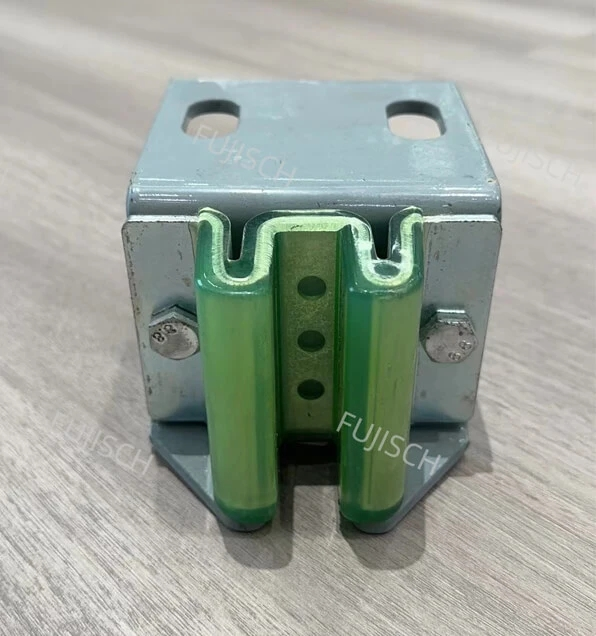Lift guide shoes are essential components in modern elevator systems, ensuring smooth vertical movement while reducing vibration and wear. Whether you're a elevator manufacturer, maintenance provider, or wholesaler, understanding guide shoes can optimize efficiency and safety in your projects. This guide covers types, functions, installation, and replacement of guide shoes for elevators, helping you make informed procurement decisions while considering elevator guide shoe price and performance factors.
A lift guide shoe is a precision-machined component that helps elevator cars glide along guide rails with minimal friction. Typically made from durable materials like polyurethane, nylon, or metal alloys, these shoes maintain alignment and absorb operational vibrations. For vertical transportation systems, the right guide shoe enhances ride comfort, prolongs rail lifespan, and reduces noise. Many elevator door shoes also integrate with guide mechanisms for synchronized movement. B2B buyers should pay attention to load capacity, material wear resistance, and compliance with international elevator safety standards (EN 81, ASME A17.1) when sourcing these parts.
The two main guide shoe for elevator systems are sliding (friction-based) and roller (wheel-based) guide shoes. Sliding shoes, often made from nylon or composite materials, provide cost-effective, low-maintenance operation for mid-speed elevators. Roller guide shoes, equipped with bearing-mounted wheels, reduce friction in high-speed elevators, improving energy efficiency and ride smoothness. Some specialized designs include adjustable guide shoes, which help compensate for rail misalignment, and fire-resistant models, compliant with stringent safety certifications. When evaluating elevator guide shoe price, buyers should weigh durability, speed compatibility, and installation complexity for long-term ROI.
The primary role of a guide shoe is to keep the elevator car aligned within the shaft while minimizing wear and tear on guide rails. These components absorb lateral forces during travel, preventing excessive sway and ensuring passenger safety. Additionally, well-designed elevator door shoes integrate with guide mechanisms to maintain smooth opening and closing operations. By reducing friction, guide shoes extend the lifespan of rails and minimize motor strain, leading to lower energy consumption. For B2B buyers, prioritizing low-noise, high-durability guide shoes helps reduce maintenance costs and enhances system reliability. Properly functioning guide shoes also help meet safety compliance standards, preventing unexpected downtime in commercial and residential elevators.

Installing guide shoes for elevators requires precision to ensure optimal performance and longevity. First, the guide rail alignment must be verified using laser measuring tools to avoid premature wear. The shoes should be mounted with proper clearance, allowing smooth movement without excessive play. Lubrication, if applicable, must be adjusted based on sliding material type (e.g., nylon vs. metal) per manufacturer guidelines. For roller guide shoes, bearing preload and wheel tension must be calibrated to avoid misalignment. Technicians must also inspect elevator door shoes for synchronization with the guide mechanism. Compliance with OEM specifications and local elevator codes is mandatory to ensure safety and performance. Buyers should partner with suppliers offering detailed installation support, especially when dealing with high-speed or heavy-load elevator systems.
Replacing a guide shoe for elevator systems involves elevator shutdown, inspection, and precise adjustment. Technicians must first secure the car and document wear patterns to determine if guide rails also need servicing. After removing the old shoe, check for rail surface damage—excessive pitting may require repairs. The new elevator guide shoe should be mounted with alignment tools to ensure proper contact pressure along the rail. For roller shoes, bearings must be tested for smooth rotation and regreased if necessary. After installation, test runs should be conducted to confirm noise reduction and smooth acceleration. When procuring replacements, buyers should compare elevator guide shoe price against durability warranties and review product compatibility with existing rail profiles. Regularly scheduled replacements (every 3–5 years, depending on usage) help prevent catastrophic system failures.
Final Considerations for B2B Buyers
Choosing the right guide shoes for elevators depends on speed ratings, load capacity, and environmental conditions (e.g., humidity, temperature). Partnering with a reliable supplier ensures access to high-quality elevator door shoes and guide mechanisms at competitive elevator guide shoe price points. Investing in durable, well-engineered guide shoes ultimately minimizes maintenance costs while enhancing ride quality and safety. Request a bulk quote today to upgrade your elevator systems with precision-engineered guide shoes!